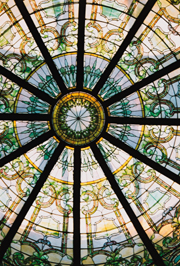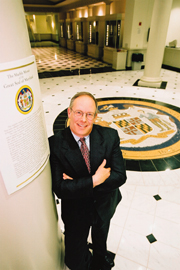The Dome Comes Home
By Carolyn Lee
Nearly one hundred years
after theTiffany dome was created, visitors can once again experience
the full brilliance of this magnificent gem in its third home,
the rotunda of the recently completed Thomas V. Mike Miller Jr.
Senate Building.
 "I
was not around for the first, but I was for the second and third,"
says Sen. Robert R. Neall, who, in reference to the multiple moves
the glass dome has made, envisioned and implemented the transition. "I
was not around for the first, but I was for the second and third,"
says Sen. Robert R. Neall, who, in reference to the multiple moves
the glass dome has made, envisioned and implemented the transition.
In 1976, the Tiffany dome was moved for the second time to a housing
in the ceiling of the Joint Hearing Room of the Legislative Services
Building, where it was enjoyed by its occupants, but not usually
by the general public. And, for the past quarter century, the
colorful leaded glass skylight had been illuminated by eighteen
500-watt quartz iodized flood lamps in an attempt to replace the
source of natural light for which it was originally designed.
The dome, which was designed and built by Louis Comfort Tiffany
in 1903, was commissioned specifically for the Court of Appeals
(formerly in the State House) in a new building on State Circle
designed to provide office space for the legislature, the judiciary
and other government offices.
Along with the five pieces Tiffany built for the State House,
the dome was installed in its first home in the Court of Appeals
in 1904 and remained a focal point of the Edwardian structure
until 1974 when it was dismantled and reinstalled, two years later,
in the ceiling of the Joint Hearing Room of the Legislative Services
Building.
 Louis Comfort Tiffany, one of three sons of the wealthy Charles
Tiffany and known in his day as the "King of Diamonds," set himself
the goal of putting a piece of Tiffany glass---windows, blown
glass or the fashionable table lamps---in every household in America.
Tiffany glassware was at its best at the turn of the 19th century,
and the finest examples of Art Nouveau masterpieces were produced
by a small but productive and influential group of artists and
craftsmen at the Tiffany Studios.
Louis Comfort Tiffany, one of three sons of the wealthy Charles
Tiffany and known in his day as the "King of Diamonds," set himself
the goal of putting a piece of Tiffany glass---windows, blown
glass or the fashionable table lamps---in every household in America.
Tiffany glassware was at its best at the turn of the 19th century,
and the finest examples of Art Nouveau masterpieces were produced
by a small but productive and influential group of artists and
craftsmen at the Tiffany Studios.
According to Sen. Neall, the idea of using the Tiffany dome in
the Senate Building was "serendipitous." He recalls, "When the
new Miller Senate Building was initially designed, the plans called
for a four-story atrium. During the construction process, however,
we made some changes to make the interior more attractive and
more functional. We decided to eliminate the atrium and were looking
for a strong architectural feature---a rotunda, perhaps. We thought,
'Wouldn't it be nice if...' And then, it just hit us---what we
needed was a skylight, and my mind went immediately to the Tiffany
dome in the Joint Hearing Room of the Legislative Services Building.
"We needed to get permission to move it. Sketches were done so
we had something to show. Then we had to secure a contractor who
could remove it and refurbish the glass. There were some problems
with the dome---it was warped in places and some of the lead was
damaged-so there was conservation and restoration work to be done."
Overall, the Tiffany dome is 20 feet in diameter. It is comprised
of 49 sections, including the top center piece which is three
feet in circumference. The other 48 pieces vary in size and together
they form the 12 pie-shaped sections that comprise the dome. "It
was reinstalled in its new location (Miller Senate Building) with
expansion joints," says Sen. Neall, who explains that "it was
mortared into place in its previous location and that [rigidity]
caused the warping."
The dome was removed by Waters Craftsmen, Inc., recalls Sen. Neall.
"There were a lot of days when I used to just stand there and
watch what was going on. My nightmare was that someone would pick
up a hammer and a chisel and, don't you know, the very first day
one of the workmen did just that!"
To protect the 100-year-old panels in transit, each section was
individually crated. The crates were divided into four trucks
for transport to the Waters Craftsmen's workshop in Front Royal,
Va. In this way, only a portion of the historic dome would be
lost in the event there was an accident en route. Sen. Neall,
for whom this had become an intensely personal project, admits
to making more than one trip to the workshop to check up on the
glass.
Now safely installed in its new location, the dome is protected
by a section of roof which is open to light and covered by specially
tinted glass that's thick and strong, thus protecting the dome
from the weather, physical objects (such as falling tree limbs)
and from ultraviolet light, which is harmful to the antique stained
glass.
Sen. Neall is quick to point out the interesting combination of
19th century technology and its 20th century counterpart, a theme
that is consistent with the new Senate Building. "We have a Georgian
Colonial motif," says Sen. Neall. "Even though this building is
filled with 'whiz bang' technology, I wanted it to look 100-years-old.
We've kept it traditional, with restored antique mantles and mirrors
that, like the dome, were once part of the old Court of Appeals
building."
The placement of the Tiffany dome in the rotunda creates a dramatic
entrance for the visitor to the building. "Important things happen
here," says Sen. Neall, "The Miller Senate Building is the site
for all of our public activities---all of the major hearings,
briefings, public testimony and voting sessions in committee.
With the exception of what we do on the Senate floor, virtually
everything else takes place in this building."
The building was designed with the public in mind, and the use
of the Tiffany dome in the rotunda to replace the four-story atrium
created four grand gallery spaces for exhibitions and public gathering.
Four stories below the dome, the exquisite marble mosaic of the
Great Seal of Maryland, 10-feet in diameter, adorns the entrance
to the Senate building.
According to Vicky Fretwell, public information officer in the
Office of the President of the Senate, "the plan always called
for a replica of the State seal in the floor. When we redesigned
the foyer to accommodate the dome, it became apparent that the
mosaic could go directly beneath it."
Ms. Fretwell explains, "It was originally to be made of terrazzo,
although terrazzo is more muted and not as clearly defined as
mosaic tile."
But Sen. Neall had seen the work of Sara Baldwin of New Revenna
Mosaics and Stone when he was visiting friends on the Eastern
Shore of Virginia. "I showed her the seal on my ring and then
sent them a CD. They, in turn, supplied us with a small template
of the proposed mosaic design so we could carefully consider our
decision."
In the end, the decision was made to choose mosaic tile over the
terrazzo process in order to more effectively convey the story
of the seal through the sharper color and finer detail of the
mosaic tiles. It took several months for the design to be completed
in the Exmore, Va., studio. Then the pieces had to be cut, placed
on an adhesive background material and divided into eight sections
for delivery. When it was installed, "the group worked at night
so as not to interfere with the daytime construction workers or
their dust," says Ms. Fretwell.
In a poignant footnote, Ms. Fretwell recalls that the State seal
mosaic was the very first large project for a new employee of
the Virginia company---a welfare mom, formerly a crab picker,
who was approached by New Ravenna for the manual dexterity required
to handle the small, irregular pieces of tile---like a jigsaw
puzzle, every piece had to fit together on site.
The visitor to the new Miller Senate Building can now enjoy the
experience of standing on one work of art while viewing another.
Thoughtfully placed with full exposure to natural light, the Tiffany
dome above illuminates the State seal four stories below in exactly
the way Louis Comfort Tiffany might have imagined.
Portions of this article were excerpted from The Capital Connection newsletter through the courtesy of Vicky Fretwell, public information officer, Office of the President, The Senate of Maryland.
|
Back
|

